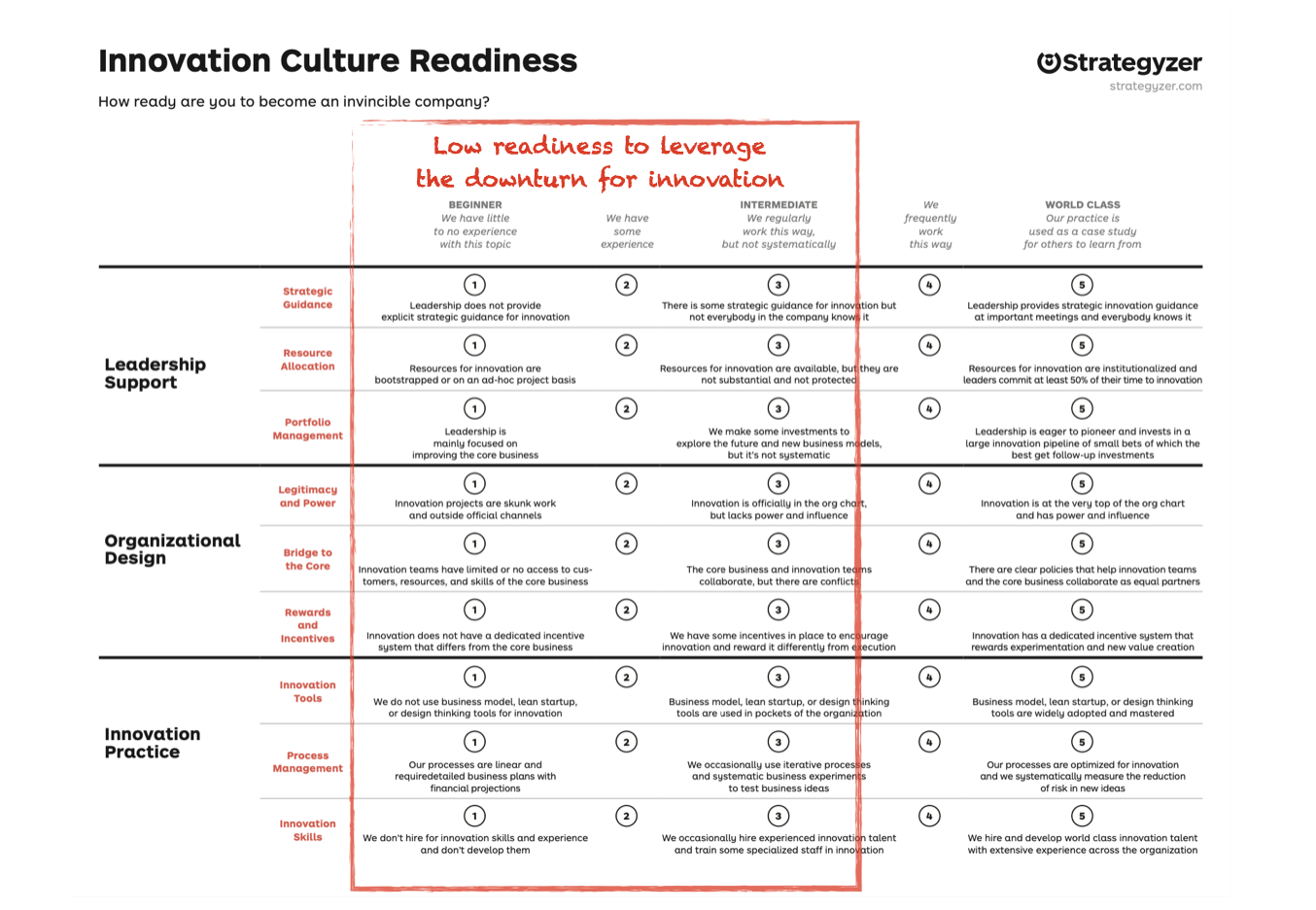Innovation in a downturn?
As the COVID crisis now evolves into an economic downturn, more and more leaders will increase their focus on the core business, even if it is at the expense of future growth. Given the current economic forecast, corporate innovation might be seen as a luxury that large organisations can’t afford anymore.
Two recent articles, Innovation in a crisis: Why it is more critical than ever by McKinsey and 3 ways to innovate in a downturn by Innosight urge leaders to take a different approach, arguing that innovation still has a key role to play to help organisations come out of the downturn stronger.
McKinsey advises that “particularly in times of crisis more urgent actions to take include:
adapting the core to meet shifting customer needs,
identifying and quickly addressing new opportunity areas being created by the changing landscape,
re-evaluating the innovation initiative portfolio and ensuring resources are allocated appropriately,
building the foundation for postcrisis growth in order to remain competitive in the recovery period.”
There is also a competitive angle, with an opportunity to make headway at a time when many competitors will freeze their innovation budget. I have never followed F1 racing but this quote from late Brazilian champion Ayrton Senna is a great metaphor of the window opportunity in the downturn.
“You cannot overtake 15 cars in sunny weather, but you can when it’s raining.” Ayrton Senna
While I fully support the call to action, I also want to acknowledge that it might not be for everyone. In this blogpost I highlight three considerations that will give leaders a deeper understanding of whether they can action the above recommendations in their context.
Those three things to consider are:
The magnitude of the resource crunch impacting corporate innovation,
The leadership bandwidth available for innovation topics,
The innovation readiness of their organisation.
Magnitude of resource crunch
Limited resource allocation is often one of the main limiting factors of corporate innovation, even in growth phases. This will get much worse in a downturn, and corporate innovation departments might see their budget slashed by cost-cutting exercises.
So, the first question leaders should clarify is the magnitude of the resource crunch for corporate innovation: what resources will remain for corporate innovation in the downturn?
One of my clients will have the budget allocated to their innovation ecosystem divided by 10 next year compared to what they had initially planned. In this context, the corporate innovation team had to honestly re-assess if they could still play a role in transformative innovation in a way that would help the organisation come out stronger from the downturn. In this case, they assessed they could still move the needle on one strategic area and decided to focus entirely on this one.
Leadership bandwidth
Mental bandwidth of executives might be an even more scarce resource. In a crisis it is counterproductive for innovation leaders to bring to executives’ attention topics that they have no mental bandwidth to process.
When innovation leaders push their agenda too hard in a crisis, that can only lead to the counter-productive decision to pause or stop everything. Innovation disappearing completely from the executive agenda is the worst possible outcome, so innovation leaders should adjust their expectation of executives’ attention to the reality of their available mental bandwidth.
They should understand: How much bandwidth is left for topics that are not directly related to the crisis? And how best to keep innovation as an executive level topic during the downturn? What should be put on hold, stopped to align with the new availability from executives?
One Head of Innovation I’m working with in Europe had paused interactions with the CEO the first three months of the war in Ukraine, and then resumed interactions only when the time was right. On a monthly rather than bi-weeky basis first. Even though some decisions couldn’t be made during those 3 months, the pause enabled to maintain strong CEO support for innovation, as counter-intuitive as it may sound.
Innovation Maturity
The organisations that show the best resilience to crises are those we call ambidextrous. Those that can balance exploitation, i.e. maximising the current business and exploration, i.e. preparing future business with a portfolio of innovation projects.
Such organisations have been building their innovation ecosystem for years and would have enough maturity to assess options and make optimal decisions on what programs and projects in their innovation portfolio should be continued, put on hold or stopped.
But in my work, I’m often in discussions with companies without a mature innovation capability yet. Organisations that have been mainly focused on their core business, with only some efficiency innovation and continuous improvement going on. They are not ready to leverage innovation for new growth. Should those organisations start building their innovation capability during the downturn? Most of the time, given innovation’s time to impact, plus the resource and leadership bandwidth it requires, I’d advise organisations with low innovation readiness against building an innovation capability in the middle of a crisis. Such organisations might have to weather the storm first and start the work on their future exploration ecosystem only when they see the other side of it.
Source: The Invincible Company by Alex Osterwalder, Yves Pigneur, Fred Etiemble, Alan Smith (WILEY, 2019)
So, to understand how to best leverage innovation in the downturn, leaders should first clarify the innovation readiness of the organisation: How mature is the organisation’s innovation ecosystem? And is it mature enough to create value for the organisation during the crisis?
It’s obviously not an easy question to answer and will require a judgment call from leaders. The presence or absence of the most important enablers for innovation in a crisis could tip this judgment call on one side or the other.
In a recent Vibrance community jam, we asked our clients how they approach maintaining a focus on step out innovation and growth when operating environments become difficult. In their experience, the most important enablers to maintain this focus are:
An organisational commitment to long-term thinking and value creation,
A documented strategy that includes innovation as a key pillar,
An Executive in the leadership team dedicated to innovation and future growth.
A crisis is a terrible thing to waste, as the saying goes. The downturn could be an opportunity in disguise. An opportunity for leaders to do the hard work that would enable the organisation to come out stronger from the downturn.
Is this opportunity for you?
To assess whether you would be able to execute an ambitious innovation program during a downturn, start by looking honestly at:
The magnitude of the resource crunch impacting corporate innovation,
The leadership bandwidth available for innovation during the downturn,
The innovation readiness of your organisation, and whether the most important enablers for innovation in a crisis are present.
Note: an earlier version of this post was published on the Vibrance Partners blog












